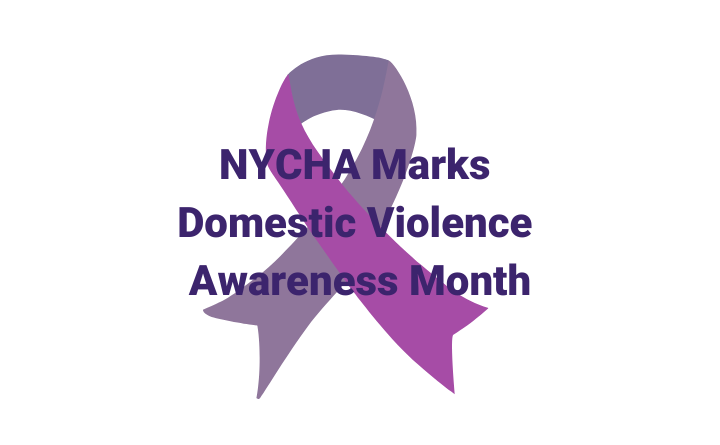NYCHA Holds 2022 Intimate Partner & Domestic Violence Conference
To mark National Domestic Violence Awareness Month in October, NYCHA’s Resident Services, Partnerships, and Initiatives Department held a virtual event, “Intimate Partner & Domestic Violence Conference 2022: The Impact of Exposure on Youths & Teens” on October 13.
More than 150 people attended the conference, which was organized jointly by NYCHA’s Queens-Staten Island Family Partnerships and Brooklyn Family Partnerships. The event featured representatives from partner organizations: Day One, which works with young people to end dating abuse and domestic violence. Sanctuary for Families, a leading service provider and advocate for survivors of domestic violence and related forms of gender-based violence; and the New York City Police Department Police Service Area (PSA) 9, which serves several NYCHA developments in Queens: Astoria, Baisley, Conlon Lihfe, Pomonok, Queensbridge, Ravenswood, South Jamaica, and Woodside.
The panel opened with the viewing of a video from Day One, “Sunshine – Don’t Confuse Love & Abuse,” which illustrates an example of dating abuse in a teen relationship.
Day One representatives discussed services provided to young people 24 and under to create healthy partnerships, what exposure to intimate partner violence and domestic violence may look like in various age groups, and ways children can heal, including by having the opportunity to speak with adults about domestic violence, ask questions, and talk about their feelings without being shamed.
Sanctuary for Families discussed technology abuse and defined the four forms, which include digital disrespect by sharing private photographs, constant messaging, online stalking, and impersonating through social networking (such as creating fake profiles). They also shared how parents can support their young people by providing non-judgmental communication, education and awareness, modeling healthy behaviors, spending time with teens, and helping them seek outside help.
NYPD PSA 9’s Youth Coordination Officer discussed how young people can discern the difference between good and bad conflict and the signs of an abusive relationship, as well as ways PSA 9 can assist if a young person is experiencing intimate partner or domestic violence.
The event also featured audience participation questions (see questions and answers below) on intimate partner and domestic violence and the recitation of a poem written by a domestic violence survivor Lynette Gutwein, “Returning Faith.”
Audience Participation Questions:
- What estimated number of people in the U.S. experience domestic violence every year?
- 2.4 million
- 330,000
- 6 million
- 10 million
(National Coalition Against Domestic Violence)
- Which state has the highest rate of domestic violence?
- Florida
- New York
- North Carolina
- Oklahoma
(U.S. Census Bureau)
- What percentage of children of all ages have been exposed to physical intimate partner violence in their lifetime?
- 9.4%
- 60%
- 17.9%
- none of the above
(CDC)
- Among high school students who dated, what percentage of teen girls experienced physical and/or sexual dating violence.
- 40%
- 5%
- 21%
- 11%
(Teen boys, 10%) (CDC)
- Since COVID-19, violence against women has increased to unprecedented levels. In the U.S., the National Commission on COVID-19 and Criminal Justice shows an increase by what percentage following the imposition of lockdown orders during 2020?
- 3%
- 21%
- 8%
- Other ___%
- Any external factors that add stress, isolation, and financial strain can create circumstances where a survivor’s safety is further compromised. COVID-19 has elements of all three.
- True or False
(Shelter-in-place orders meant that many would be in closer and more frequent proximity to their abusers.)
(National Domestic Violence Hotline)
- About 11 million women and 5 million men who reported experiencing contact sexual violence, physical violence, or stalking by an intimate partner in their lifetime said that they first experienced these forms of violence before the age of 18.
- True or False
(CDC)
- The frequency and severity of teen dating violence increases with age. In addition, the likelihood of being subjected to violence in a relationship increases for teens who:
- live in poverty, come from disadvantaged homes, or receive child protective services experience stressful life events or show symptoms of trauma
- have been exposed to harsh parenting; inconsistent discipline; or lack supervision, monitoring, and warmth;
- have a friend involved in dating violence
- all of the above
(Youth.gov)

